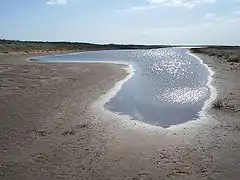Gibraltar Point
Gibraltar Point national nature reserve is an area of about 4.3 km2 (1.7 sq mi) on the coast of Lincolnshire, England.
| Gibraltar Point | |
|---|---|
 | |
 | |
| OS grid | TF560580 |
| Coordinates | 53.09641°N 0.32838°E |
| Area | 437 hectares (1,080 acres) |
| Managed by | Lincolnshire Wildlife Trust |
| Designated | 5 March 1993 |
| Reference no. | 589[1] |
The reserve is owned by Lincolnshire County Council and East Lindsey District Council and is administered by the Lincolnshire Wildlife Trust. The reserve comprises two parallel ridges of sand dunes—the "east dunes" and the "west dunes"—separated by about half a kilometre (550 yards) of salt marsh; and an area on the seaward side with further salt marsh and sand, shingle and muddy beaches. The reserve extends for a distance of about 5 km (3 mi) along the coast, from the southern end of Skegness to the northern corner of The Wash (Gibraltar Point itself is at the southernmost tip, and marks the point where the North Sea coast turns southwest towards Boston). A golf course occupies much of the west dunes (the inland side) at the Skegness end of the area. Gibraltar Point is an area of coastal deposition—at the end of the 18th century the west dunes were by the shore, but they are now a kilometre inland.
In 2016 a new visitor centre opened at the southern end of the reserve to replace the previous one which had been damaged by Cyclone Xaver. There are numerous paths around the area, and several artificial lakes and hides. The Lincolnshire Wildlife Trust also owns an old farm and land just inshore of the west dunes at the southern end of the reserve, again with an artificial lake and hides. Revenue from car parks assists in the upkeep of the area.
Gibraltar Point is part of the twice daily inshore waters forecast in the extended form of the Shipping Forecast broadcast on BBC Radio 4.
The reserve's importance is recognised by its various designations:
- SSSI (Site of Special Scientific Interest)
- NNR (national nature reserve)
- Ramsar wetland site (wetland of international importance)
- SPA (Special Protection Area).
Flora and fauna
Birds
The reserve is home to a great variety of birdlife, mostly wildfowl, waders and gulls. The geography of the area makes the reserve very popular with migrant birds and many nationally rare species have been recorded. Recently, these have included black stork, pallid harrier, caspian tern, red-flanked bluetail and rustic bunting during 2015,[2] and broad-billed sandpiper, black-winged pratincole and great reed warbler in 2014.[3]
Notable breeding birds at the site include little tern, common shelduck, ringed plover, oystercatcher and common redshank, whilst the site is of international significance for overwintering wader species such as oystercatcher, grey plover, red knot, sanderling and bar-tailed godwit. Nationally important numbers of ringed plover also overwinter.[4]
The site is home to a bird observatory, which has studied bird migration in the area since April 1949.[5]
Flora
Gibraltar Point has the most northerly colony of sea heath in Britain.
References
- "Gibraltar Point". Ramsar Sites Information Service. Retrieved 25 April 2018.
- Hudson, Nigel (October 2016). "Report on rare birds in Great Britain in 2015" (PDF). British Birds.
- Hudson, Nigel (October 2015). "Report on rare birds in Great Britain in 2014" (PDF). British Birds.
- "SSSI Citation- Gibraltar Point" (PDF). Natural England. Retrieved 13 July 2020.
- "Gibraltar Point". Lincolnshire Bird Club. Retrieved 13 July 2020.
External links
 Media related to Gibraltar Point National Nature Reserve at Wikimedia Commons
Media related to Gibraltar Point National Nature Reserve at Wikimedia Commons- Gibraltar Point Bird Observatory
- Gibraltar Point (Lincolnshire Wildlife Trust)
- Government Join Nature Conservation Committee (JNCC) Page